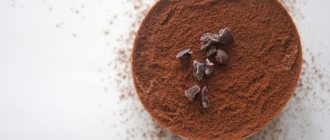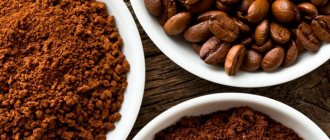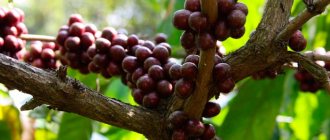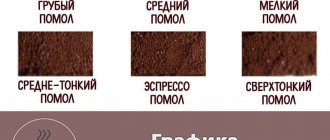| Place | Name | Characteristics in the rating |
| The best bean coffee for Turkish |
| 1 | Jardin Guatemala Cloud Forest | Premium class at a reasonable price |
| 2 | Lavazza Super Gusto UTZ | Strength and unique aroma |
| 3 | Madeo Vietnam Dalat | Multifaceted taste with a pleasant bitterness |
| The best ground coffee for Turkish |
| 1 | Illy Caffe Filtro medium roast | The best ground coffee that everyone loves |
| 2 | Paulig Classic for Turkish | Best in the mid-price segment |
| 3 | Mr.Viet Arabica | Coffee with a lot of character |
| 4 | LEBO EXTRA for Turkish | Cheap coffee of good quality |
| The best flavored coffee for Turkish |
| 1 | Musetti Chocolate flavored | Best flavored coffee |
| 2 | Molinari Sweet Break Hazelnut & Chocolate | Unique aroma of chocolate and hazelnuts |
| 3 | Jockey Irish Cream | High-quality dessert coffee at an affordable price |
A cup of strong aromatic coffee helps us wake up and get ready for a long day of work or have a good time in the company of friends. This has little to do with instant coffee - compared to grain and ground types, it has practically no taste and smell. The choice of good coffee in stores is now very large - all you have to do is decide which taste and strength you prefer. And one more thing - many coffee lovers are convinced that in an ordinary Turkish coffee pot the coffee turns out much tastier than in a coffee maker or coffee machine. Therefore, today we have prepared for you a rating of the best ground and bean coffee for brewing in Turkish.
The best bean coffee for Turkish
True connoisseurs of the invigorating drink use exclusively coffee beans, grinding them themselves in a coffee grinder. The drink prepared in this way turns out to be the most aromatic, since the finished powder does not have time to fizzle out and lose its original smell and taste. But to truly enjoy a freshly brewed cup of coffee, you need to choose the right beans. We invite you to familiarize yourself with the best, according to amateurs, varieties and brands of bean coffee, which is recommended for brewing in a Turk.
Coffee storage conditions
There are several rules for storing coffee that will preserve its taste:
- The main enemy of grains is air, so they should always be stored in an airtight container. Experts advise not to even pour the grains out of the package, but to place it all in a special jar.
- You should not grind all the grains at once; it is better to do it in small portions immediately before cooking to preserve the aroma. Ground coffee beans can be stored for about 10 days.
- The ideal storage temperature is 13-16 degrees; it should not be stored near the stove, or near spices and other strong-smelling products.
- There is a way to store beans in the freezer, but airtight packaging is also important here. Repeated freezing is contraindicated, so you should first package the coffee in portioned bags.
Single-origin coffee or blend – what to choose?
Specialty stores sell gourmet grains. There you can make your own blends of Arabica and Robusta. Sellers can tell you the best proportions for blends. Also in specialized stores you can purchase the best varieties of ground coffee for a coffee maker or for Turkish coffee. The seller, at the request of the client, will grind the grains to the desired degree. There are also single-origin coffees that are a constant success among gourmets. This:
- Harari from Ethiopia. It is distinguished by its strength and rich bitter-chocolate taste.
- Santos from Brazil. Arabica of this variety has a balanced, “pure coffee” taste without any impurities. The drink turns out thick and aromatic. Santos is an excellent base for blends.
- Kilimanjaro from Kenya. Arabica plantations are planted on the slopes of the volcano of the same name and grow quite high in a cool climate. The drink has a winey taste with a hint of spice and a rich aroma.
- Geisha from Panama. Lime notes, distinct sourness, delicate bouquet.
- Monsoon coffee from India. The grains for this variety are dried on the seashore. A dense drink without any sourness. There is a slight sweetness in the taste.
- Mocha from Yemen. Excellent ground coffee for coffee makers and Turks. The drink has a velvety structure, thick, with notes of chocolate and spices. Also good for blends.
- Antigua from Guatemala. Completely devoid of bitterness. Just the rich taste and aroma of milk chocolate.
- Blue Mountain from Jamaica. Delicate, soft, will appeal to those who do not like too strong coffee. It is usually mixed with Robusta to add expression.
Signs of quality coffee beans
You should not drink instant coffee, because it will not be possible to check the quality of the raw materials for its preparation. To experience maximum pleasure from the ceremony, espresso must be made from natural ingredients, that is, from coffee beans.
First, pay attention to the integrity of the beans. Their structure should be uniform. The presence of nicks, scratches and cracks indicates improper storage of the fruit. It is also possible that they were damaged during transportation. But in any case, low-quality raw materials will have to be removed.
Evaluate the color of the grains. They should be bright green and shiny. The oily shell indicates freshness. If it is not there, the fruits were probably overexposed in the storage room.
Arabica or Robusta: Preferences Matter
Lovers of freshly brewed coffee hone their craft. With experience, they prepare an excellent aperitif: no worse than in an expensive coffee machine. A new question arises: what type of coffee should you buy for making it yourself?
It’s better to buy your favorite blend or single variety, following a few tips:
- Arabica has a characteristic sweetness and sourness. Robusta has a pleasant bitterness, and when it is brewed, the bitterness intensifies slightly.
- Robusta contains more caffeine, which means the drink is stronger than Arabica.
You can cook ground grains from a mixture of two varieties. If you need an invigorating effect, a content of 20-30% robusta is the best option.
Coffee selection criteria
Many people pay attention to promotional offers and buy a low-quality product only because its price is halved. To enjoy the taste of an aromatic drink, first of all you should know which brands of coffee products are considered the best. By choosing a trusted manufacturer, you can be confident in the quality of the products. Connoisseurs of the drink, having chosen the best brand, do not change it for decades.
What you should pay attention to when choosing good Turkish coffee:
- taste and aroma of the product;
- price policy;
- ratio of quality and price;
- popularity in the coffee market;
- recommendations from professionals.
To choose the right brand for yourself, it is advisable to try the products of several world-famous manufacturers. If you are satisfied with the quality of the prepared drink, you will know which brand you will buy next time.
The taste of the drink depends on the choice of coffee beans
Variety
The most necessary information on the label is the country of origin. The best coffee trees grow in Kenya, Colombia, and Costa Rica. The Arabica variety is considered one of the best. It has a light delicate taste and rich aroma. Professionals do not like to use robusta for cooking in Turk, but for those who love a strong drink, robusta is an ideal option. True, it is better not to abuse it, and use it infrequently.
On a note! To make the drink strong, and at the same time aromatic, with a rich taste, robusta beans are mixed with Arabica.
Region of growth
The largest supplier of grains is Brazil. The largest volume of coffee beans in the world comes from this country. Brazilian Arabica has about 40 varieties.
Another leader in the coffee market is Kenya. The country is famous for both tea and coffee industries. Kenyan coffee beans have a light currant flavor and slight sourness.
Colombia is a major world exporter of coffee. The grains from Colombian plantations are of high quality. Compared to Kenyan and Brazilian products, Colombian beans taste more delicate and light.
Grain grinding degree
Without proper grinding of the grain, a real drink cannot be made. The degree of grinding of coffee varies:
- very fine grind;
- average;
- large;
- very large.
What ground coffee is best to use for Turkish coffee? The finely ground particles in the Turk do not settle to the bottom, so the drink may turn out cloudy. If you use a coarse grind, the Turk stays on the fire a little longer. At the same time, the contents of the Turka must not be allowed to boil.
It is advisable to grind the grains immediately before use. If there is any unused powder left, its shelf life is 10 days.
Grinding beans
Roasting coffee beans
Everyone knows that the beans are pre-roasted. There are several degrees of roasting, each of which has individual taste and aroma characteristics. There is no uniform classification for roasting beans. In some countries they use a scale from 1 to 5, and roasting can also be called “Viennese”, “Scandinavian”, “American”, etc. If a roast is assigned a number, the least would be the lightest roast and 5 would be the deepest roast.
Signs of quality coffee beans
When purchasing coffee beans in a supermarket, first of all, we pay attention to the packaging. You can often find eco-friendly paper bags in which grains are packaged. In this case, you should buy no more than 200 grams of beans, because beans are stored in paper packaging for 10-14 days.
As for vacuum packaging, it must be hermetically sealed and not damaged anywhere.
When buying grains by weight, you need to pay attention to their appearance. The beans should be approximately the same size and shape.
Another sign of quality products is their characteristic aroma. If there is a rancid, unpleasant smell, it is better not to buy such beans.
Roasting secrets
Raw grains are supplied to the wholesale market. This makes them easier to transport, because fried beans are brittle and absorb moisture like a sponge. Raw coffee has a pale or light green appearance and is completely unappetizing. And the grains taste like bitter burnt rubber or poorly roasted peanuts. Different countries that buy raw materials and package them use their own roasting methods.
Italian was recognized as the best. We will not go into the intricacies of technology here. Let's just say that beans roasted using this method give an abundant foam cap on the surface of the drink. In addition, the Italian type allows the beans to be stored for a long time without losing their aroma.
There are three degrees of roasting. When weak, the grains have a light brown color. Medium roast gives the coffee a hint of chocolate. A strong degree of heat treatment brings the grains to a dark brown, almost black color. Then a bitterness and a smoky smell appears. A good Turkish coffee is one that has undergone a strong or medium roast.
Reviews
Elena: “I brew the drink exclusively in Turk. Cooking time including all preliminary preparations is no more than 15 minutes. I buy grains in packages, I’m afraid to buy them by weight. No one will say how long and under what conditions they were stored in the store. I really love the Melitta brand. The taste is delicate, without sourness or bitterness. I store the grains in the refrigerator in a special glass jar.”
Oleg: “I love Lavazza, and my love has lasted for many years. I tried a variety of brands, but Lavazza is exactly what I need. In the morning I can’t get out of bed until I have a cup of my favorite drink. Fortunately, my wife spoils me every morning and brings me coffee in bed. No sugar, cream, milk - only natural coffee! I buy beans and grind them in a coffee grinder.”
Inna: “I used to drink instant sublimate, but then I switched to ground. Incomparable sensations! I don’t follow the proportions of Turkish coffee; I do everything by eye. Maybe it’s wrong, but my drink turns out rich and very tasty. I buy ground coffee in a special store where they grind the beans in front of me. You need to buy a coffee grinder and grind it yourself at home.”
True coffee connoisseurs know that to obtain a truly aromatic drink, every detail is important: choosing the right cup, grains, their storage and grinding, and the preparation recipe. Follow all the recommendations of specialists, and every morning you can enjoy the truly magical taste of an enchanting drink.
Tips for beginners
Coffee should be brewed according to simple recommendations.
- High-quality purified water, not tap water. Even elite varieties lose the richness of taste and aroma due to interaction with chlorine.
- Proportions (1:10). For example, 15 g of ground powder per 150 ml. The strength is adjusted by increasing the portion of coffee and vice versa.
- Dry additives (sugar, spices) are mixed with ground coffee, liquid ingredients (honey, syrup) are first dissolved in water, milk is added to the cup.
The third component of the ideal drink: the hand
Now all that remains is to figure out how to brew good Turkish coffee. There are two ways: on fire or in sand. The second one is more authentic. This way the Turk warms up not only from the bottom, but from all sides.
- Pour clean and dry sand into the pan.
- Warm it up, stirring.
- We install the Turk. Warm up the vessel for 10 seconds.
- Pour 7 g of coffee per serving. If you like a sweet drink, add sugar immediately. Then you can add seasonings (cinnamon, cardamom).
- Fill in 100 milliliters of cold, preferably even ice water. The liquid level should reach the narrowest part of the neck of the cezve.
- We move the Turk along the sand until the coffee warms up to 90-95 degrees. Under no circumstances should the drink be brought to a boil, otherwise all the aroma will disappear and the taste will be spoiled.
- Foam will appear on the surface of the coffee. We lift the cezve and wait for it to fall. There is no need to place the dishes on a cold surface - just hold them over the frying pan (or fire).
- Place the cezve in a hot environment again. We repeat this three times.
- The presentation of the drink is no less important. We place the Turk on the table on a saucer. We serve the guest a small cup with a coffee spoon and the same glass of cold water.
Cooking technique
There are many recipes, but according to the rules, a dense foam is sure to form. We are sharing a classic recipe with which even inexperienced gourmets can prepare delicious aperitifs. Step by step, coffee is brewed in a Turk in the following way.
- Take a Turk (copper, ceramic, clay), add ground powder.
- Pour in water and place on the stove, turning on medium heat.
- Wait until it boils - the foam will begin to rise to the neck.
- Remove the device to allow the foam to settle.
- Return it to the stove and repeat similar steps 2 more times.
- Turn off the burner; the coffee can be poured into the prepared container.
An aromatic aperitif, brewed by different masters using the same method with identical ingredients, can be very different. This is influenced by a lot of factors: what grind is chosen, how long it takes to heat up the cezve, what is the composition of the water. By experimenting with the size of grinding and roasting, and the temperature of the liquid poured, a unique flavor bouquet of a skillfully brewed drink is achieved. Experienced coffee lovers suggest: brew coffee with good thoughts based on your favorite blend, and everything will work out.
Which one is better to choose?
Coffee lovers have the opportunity to purchase any of three types of coffee:
- Grain. The most traditional look, very convenient for storage. Does not lose taste and aroma for a long time.
- Powdery. Chalked grains are used for Turks, coffee makers, and coffee machines. It is not stored for a long time, loses its aroma and absorbs other people's odors.
- Capsule. Ground grains are placed in sealed packaging. Used in capsule coffee machine.
Capsule coffee is also used for brewing in a Turk. The contents of the package are poured into the cezve and cooked in the standard way.
Daniil Lobadin
Co-founder and head of the family manufactory Lobadin Coffee Roasters
Keep the method of making Turkish coffee from the family manufactory Lobadin Coffee Roasters:
You need a copper pot, 4 teaspoons of coffee, 160 ml of water (pour water from a filter, at room temperature). Important - coffee beans should be as coarsely ground as possible, like salt crystals. Not into the dust! Forget about this ancient misconception - after all, you are going to drink coffee, not eat!











